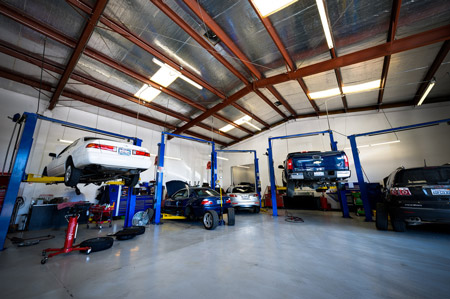Related: Oil Pit Netting
Safety in automotive shops is always of the utmost importance. Keeping your workers, yourself and your customers safe amongst the countless dangers of automotive repair is the most important principle in any shop. Many things can go wrong during everyday work at an automotive shop, but luckily there are also several ways you can ensure both your employees and your own safety. Two of the most important ways you can ensure the safety of your employees is through Oil Pit Netting and Automotive Lifting Equipment Inspections.
Oil Pit Netting
Oil pits are very common in automobile service garages, oil change shops and other repair facilities. Pits that are unprotected pose a huge threat to the safety of both employees and visitors to the said facility. Oil Pit Netting is one way you can ensure that your business will meet OSHA’s safety regulations for open pit auto service bays. The use of netting as opposed to grating also allows for more natural light for technicians to see, is more cost-effective and can be removed and cleaned easier.
Fall hazards are a clear and apparent concern when an opening in the floor is not properly protected. According to OSHA Fall Protection Regulations, such openings must be guarded or covered when not in use. Not adhering to these regulations will result in expensive ministry fines for compliance violations.
In regards to oil pit safety, loose board covers, bent and missing metal covers, nets with large holes, yellow tape, cones and caution signs are not enough to be compliant or to ensure the safe safety of your employees. This is basic shop safety but its importance cannot be stressed enough.
Oil Pit Netting Systems are specifically designed to suit your application and will provide a reliable solution with minimal impact on day-to-day operations; the unique design allows for easy movement of the netting and requires no modification of the existing automotive service pits.
Automotive Lifting Equipment Inspections
Another very important rule in automotive shop safety is to properly lift vehicles. With literally tons of steel hovering above a worker, supporting a car during a suspension, the based task can mean the difference between life and death. To demonstrate this further; in May of 2016 a car slipped off a hoist at a local St Catherine’s Costco which resulted in the worker underneath being severely injured and hospitalized.
Regular inspections help to ensure that all the lifts and hoists in the shop are operating properly. Routine inspection and maintenance should be done at least every 3 months. To make sure that an automotive lift is safe for using the following items should be inspected regularly:
Lift controls are working properly
All locks and restraints are working correctly
There is no deformation or excessive wear on any of the lift components, including posts, arms, poses or wiring
There is no damage or excessive wear on any of the lift contact points, including adapters
There are no hydraulic leaks
There are no cracks or loose concrete around the floor anchors, if applicable
In addition to inspecting the items previously stated, operating and maintenance instruction plates should be prominently displayed on the hoist. The key to minimizing ongoing maintenance costs for any piece of safety equipment is an aggressive preventative maintenance program, which will eliminate any unnecessary repair time and re-work costs. To establish how aggressive a preventative maintenance program should be, the equipment and workplace environment must first be examined to determine what level of usage the equipment is being used for, and what level of the inspection program is needed for it.
Too many people have been injured while working in automotive shops. Given the nature of the work, there is always the risk of severe injury and in the worst-case fatality. Employers must minimize these risks and employees have the right to refuse to work in unsafe conditions.
If you have any questions in regards to the safety products outlined in this posting, please do not hesitate to comment below!


